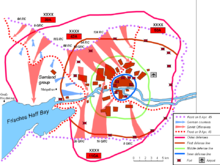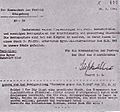Battle of Koenigsberg
| date | April 6-9, 1945 |
|---|---|
| place | Koenigsberg |
| output | Soviet victory |
| Parties to the conflict | |
|---|---|
| Commander | |
| Troop strength | |
| 47,800 (German information)
135,000 (Soviet figures) |
106,000 total strength of the siege troops
24,000 took part in the fighting between April 6 and 9, including |
| losses | |
|
no German information 42,000 dead 92,000 prisoners (Soviet data) |
18,064 dead, wounded and missing |
The Battle of Koenigsberg was a military operation during the Battle of East Prussia . From April 6th to April 9th, 1945 the troops of the 3rd Belarusian Front carried out the attack operation with the support of the Baltic Fleet , which ended with the conquest of the capital of East Prussia .
prehistory
The city of Königsberg (today Kaliningrad ) was spared the Second World War for a long time until it was heavily destroyed by British bomber forces in the nights of August 26-27, 1944 and August 29-30, 1944 by the air raids on Königsberg . Over 130,000 residents were left homeless. At the end of January 1945, Königsberg was largely surrounded by Soviet troops, the land connection via the Samland to the port of Pillau was still open, as was a corridor to the 4th Army, which was crowded in the area of Natangen and Warmia . Before the battle for Koenigsberg began in April 1945, there were still 130,000 civilians in the city; 15,000 people are said to have been affected by the final displacement of the German population in 1948.
Two-sided deployment
The information on the German troop strength varies considerably depending on the German or Soviet representation. According to the German assessment, the fortress commander General Otto Lasch (Generalkommando LXVI. AK) had four divisions, seven Volkssturm battalions and several alarm units to defend the city. At the beginning of April the total crew numbered 47,800 men with a combat strength of 28,617 men, which were joined by 5,000 members of the Volkssturm. There were also 224 guns, 160 heavy anti-tank guns and 16 assault guns. The Soviet 11th Guard Army involved in the fighting states in its war diary a strength of approx. 100,000 men from the most varied of troops.
The northern fortress front was defended by the 367th Infantry Division and the 561st and 548th Volksgrenadier Divisions. The Schubert police group and the 69th and 61st Infantry Divisions stopped on the southern section . All troops had already been exhausted from the previous fighting and were reinforced by units of the Volkssturm .
After the complete destruction of the German troops in the nearby Heiligenbeil basin , which was closed at the end of March, Marshal Alexander Wassilewski gathered his core troops to conquer Königsberg. For the conquest of the city, which had already lasted three months, a third of the entire Soviet air force was drawn together. 3 armies with a strength of 106,000 men took part in the main attack, with the troops on the eastern section (69th Rifle Corps) remaining on the defensive.
Northern section
The main attack against the northwestern fortress front of the city led the 43rd Army under Lieutenant General Afanassi Beloborodow .
- The right wing was formed by the 90th Rifle Corps (Lieutenant General Sedulin ) with the 26th and 70th Rifle Divisions
- In the middle, the 13th Guards Rifle Corps (General Lopatin ) with the 33rd and 87th Guards Rifle Divisions and the 54th Rifle Corps (Lieutenant General Alexander Ksenofontow ) with the 126th, 235th and 263rd Rifle Divisions were assigned.
- On the left wing of the northern section, 6 rifle divisions (81st and 124th Rifle Corps) of the 50th Army under Lieutenant General Oserow covered the general attack.
Southern section
The 11th Guard Army under Colonel General Kusma Galitzki was deployed against the southern attack front .
- On the left wing of the southern front, the 36th Guards Rifle Corps under Major General Koschewoi was to lead the thrust with the 16th, 18th and 84th Guards Rifle Divisions northwards to the Pregel.
- In the middle, the 16th Guards Rifle Corps under Lieutenant General Stepan Savelievich with the 1st, 11th and 31st Guards Rifle Divisions also had to push the main thrust through the southern district of Ponarth to the Pregel.
- Finally, on the right, the 8th Guards Rifle Corps under Lieutenant General Mikhail Zavadovsky with the 5th, 26th and 83rd Guards Rifle Division had to break through into the city center.
April 6-9, 1945

The spring weather with a cloudless sky continued and allowed the Soviets to launch their general attack on April 6th. On the evening of the first day of the attack, the 39th Soviet Army deployed in Samland (Lieutenant General Lyudnikow ) succeeded in interrupting the Königsberg- Pillau railway line (see Samland Railway ), as it did two months earlier. The Soviet 43rd Army invaded the city first. After two days of heavy fighting, the city's garrison was cut off from the Samland. General Lasch requested that the 5th Panzer Division be deployed from the west. After the first acceptance, it was withdrawn the next day. The map showed that Königsberg was to be cordoned off from the road to Pillau.
Lasch applied to General Friedrich-Wilhelm Müller for permission to break out of the city occupation to the west, with the civilian population being taken along. But the army high command in Pillau refused in the strongest form, although it could neither send relief to the city nor launch a relief attack.
On April 8, the enclosed German units again refused the city's surrender offered by the Soviet Union. Shock troops established contact with the 561st Volksgrenadier Division . This attacked from the west with parts of the 5th Panzer Division . The civilian population had to be smuggled through between the relay chains of the shock troops.
General Lasch was informed by party officials that the population should be ordered to assemble on the arterial road to the west half an hour after midnight for the outbreak. The relief attack was to begin at 11 p.m., and at 4 a.m. the 5th Panzer Division was to advance against the containment ring from outside. The attack succeeded at first, but then got stuck. The civilian population marched on the arterial road to the west, Soviet artillery fire blocked the road, the leader of the outbreak, Major General Erich Sudau , was killed, as was Gauleiter Deputy Ferdinand Großherr . Civilians and soldiers fled back to the city without a leader.
On the morning of April 9th, the German troops tried to make their way west. The 43rd Army prevented the outbreak. The attack by the German 5th Panzer Division from Samland was unsuccessful. After a long bombardment, the Soviet 11th Guard Army, supported by 1,500 aircraft, attacked the city center and finally forced the garrison to surrender. Hitler thereupon had Lasch sentenced to death in absentia. The number of fallen German soldiers can no longer be clearly determined today. No official information is available from the German side. Recent Russian research has evaluated figures from the war diaries of the Soviet units involved. According to this, around 42,000 German soldiers were killed and around 92,000 captured, including three generals. No reliable figures on civilian casualties are available.
photos
Captured officers of the German Wehrmacht at the Königstor of Koenigsberg, April 12, 1945
See also
- Kaliningrad war cemetery - collective cemetery
- Palmnod Massacre
- Metgethen massacre
- East Prussian Nights , the work of Alexander Solzhenitsyn , who was an eyewitness
- Vistula-Oder operation (simultaneous operation in the southern section of the front)
- Battle for Wroclaw
literature
- Otto Lasch : This is how Königsberg fell. Motorbuch Verlag, ISBN 3-87943-435-2 (1959, 1994)
- Wagner, Gelnhausen: Königsberg / East Prussia: We just wanted to live. Berlin 2009, ISBN 3-86683-451-9 .
- Herbert Noé: ahead of death: East Prussia 1945. Rauterberg 2007, ISBN 3-8003-3131-4 .
Web links
- East Prussian Operation in Soldaty 20 weka (Russian)
- East Prussian attack operation in "Great Patriotic War" (Russian)
Individual evidence
- ↑ a b c Gennadi Kretinin: The battle for Königsberg: number and victims of the opponents and the civilian population. (PDF; 330 kB) In: Problemy Nazionalnoi Strategii , No. 2 (11), 2012, pp. 138–154 (Russian)
- ↑ Richard Lakowski: The collapse of the German defense between the Baltic Sea and the Carpathian Mountains . In: The German Reich and the Second World War . Volume 10/1. Munich 2008, p. 547.



